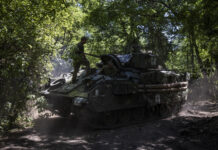
An investigation into several U.S., Danish, British and Australian airstrikes that accidentally decimated positions belonging to Syrian government forces in September concluded that the attack was the result of multiple human errors, the Pentagon announced Tuesday.
U.S. Air Force Brig. Gen. Richard “Tex” Coe, the officer who oversaw the investigation, told reporters that intelligence assets monitored a vehicle believed to have been aligned with the Islamic State in eastern Syria’s Deir al-Zour province, and followed it to a position with dozens of troops, tents, entrenchments and at least one tank.
On Sept. 17, that position was struck by F-16s, F-18s, drones and A-10 ground attack aircraft, dropping 34 precision-guided munitions and firing 380 rounds of 30mm cannon fire within the span of an hour, killing dozens of Syrians. Coe said the presence of the vehicle, compounded by the troops’ lack of uniforms or identifying features, gave the targeting personnel watching the area what he called “confirmation bias,” and they concluded they were looking at an Islamic State encampment.
While Coe said the larger area had been monitored for multiple days, he would not comment on how long U.S.-led forces watched the encampment itself before it was bombed, saying that it was classified along with other parts of the report.
At least one analyst located in the U.S. command center said the targets “couldn’t belong to [the Islamic State],” Coe said, but that analyst’s assessment did not make it to the decision-makers involved in directing the strikes.
Coe said there was no misconduct or wrongdoing by the pilots and intelligence personnel responsible for the strikes.
“They get it right more often than not, but this time they came up short,” he added.
The strikes were eventually called off after Russian officials alerted their U.S. counterparts that they were targeting Syrian troops. Coe said U.S. forces had alerted the Russians – who are conducting their own air campaign over Syria – that U.S. and coalition aircraft would be striking in the area, but the service member responsible for passing the location of the proposed strikes accidentally gave the Russians inaccurate information.
The Russians voiced no concern after the initial call, but contacted the Americans after the strikes began to inform them that they were bombing Syrian government forces. According to Coe, the Russian’s waited 27 minutes to talk to their usual point of contact in the U.S. command center – an officer who was on the other side of the base – while the strikes continued, instead of talking to the colonel who picked up the phone. During that time the Russians declined to leave a message, hung up once, called back and declined to leave a message again, Coe said.
In those 27 minutes, 15 of the 34 strikes occurred, Coe added.
About 15 people were kill in the strikes, Coe said; however Russian and Syrian news organizations put the death toll at well over 60.
Russian Foreign Minister Sergei Lavrov said at the time that the battlefield around Deir al-Zour had been “static” for two years and dismissed U.S. claims that the area had been under aerial surveillance for two days before the strike. “Government troops surrounded by ISIL, and that’s it,” he said, using an acronym for the Islamic State. “If this is a mistake after two full days of intelligence and of targeting, then we also want an investigation, frankly speaking.”
The errant strikes highlight the difficulty of targeting combatants when there is little to no U.S. ground presence, and U.S. forces rely heavily on drone feeds and the dozens of analysts tasked to monitor them. In the case of the Deir al-Zour strikes, Coe said that U.S. personnel watching the area had limited “knowledge of the terrain” and that it was a contributing factor in the incident.
Coe also said the United States is still unable to determine who they actually struck, but the targeted fighters were more likely than not aligned with the Syrian government. At the time, Syrian government troops and Islamic State militants had been fighting in the area, and pieces of territory had changed hands several times before the airstrikes.
“In this instance, we did not rise to the high standard we hold ourselves to, and we must do better than this each and every time,” Lt. Gen. Jeff Harrigian, the commander of the U.S. Air Force in the region, said in a statement. According to Coe, Harrigian has since ordered improvements to the targeting process, including better information-sharing between analysts in the Combined Air Operations Center, known as the CAOC. He also recommended better use of the “deconfliction” hotline with the Russians.
(c) 2016, The Washington Post · Thomas Gibbons-Neff
{Matzav.com}











